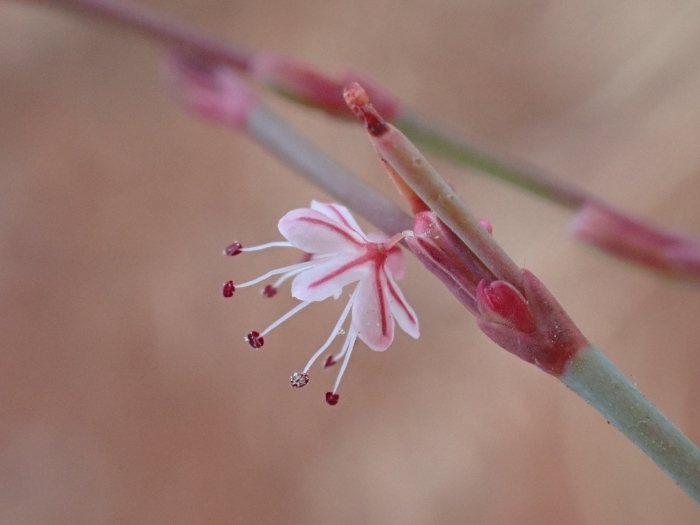Wickerstem Buckwheat
(Eriogonum vimineum)
Wickerstem Buckwheat (Eriogonum vimineum)
/
/

© Chloe and Trevor Van Loon
CC BY 4.0
Image By:
© Chloe and Trevor Van Loon
Recorded By:
Copyright:
CC BY 4.0
Copyright Notice:
Photo by: © Chloe and Trevor Van Loon | License Type: CC BY 4.0 | License URL: http://creativecommons.org/licenses/by/4.0/ | Uploader: chloe_and_trevor | Publisher: iNaturalist |
























Estimated Native Range
Summary
Eriogonum vimineum, commonly known as Wickerstem Buckwheat, is an annual herb native to the sagebrush steppe, dry mountain slopes, and desert scrub of the Northwestern United States, including California and Nevada. It is particularly common in the Sierra Nevada range. This plant typically grows up to 12 inches tall and forms basal rosettes of rounded to oval leaves. The stems are wiry and erect, giving rise to its common name. It produces an array of branching inflorescences with clusters of small, pom-pom-like flowers that range in color from pink to yellowish or white, each flower striped with darker midribs. The flowering season extends from late spring to early fall, with the flowers being moderately showy.
Wickerstem Buckwheat is valued for its drought tolerance and ability to thrive in poor, rocky soils, making it an excellent choice for xeriscaping and naturalistic plantings in arid regions. It is also used for habitat restoration projects as it provides nectar for pollinators and seeds for birds. In cultivation, it requires minimal water once established, well-drained soils, and full sun exposure. While it is not commonly found in traditional garden settings, its resilience and ecological benefits make it a suitable candidate for native plant gardens and wildflower meadows.CC BY-SA 4.0
Wickerstem Buckwheat is valued for its drought tolerance and ability to thrive in poor, rocky soils, making it an excellent choice for xeriscaping and naturalistic plantings in arid regions. It is also used for habitat restoration projects as it provides nectar for pollinators and seeds for birds. In cultivation, it requires minimal water once established, well-drained soils, and full sun exposure. While it is not commonly found in traditional garden settings, its resilience and ecological benefits make it a suitable candidate for native plant gardens and wildflower meadows.CC BY-SA 4.0
Plant Description
- Plant Type: Herb
- Height: 1-1.5 feet
- Width: 1-1.75 feet
- Growth Rate: Moderate
- Flower Color: White, Pink, Yellow
- Flowering Season: Spring, Summer, Fall
- Leaf Retention: Deciduous
Growth Requirements
- Sun: Full Sun
- Water: Low
- Drainage: Fast, Medium
Common Uses
Drought Tolerant, Low Maintenance
Natural Habitat
Sagebrush steppe, dry mountain slopes, and desert scrub
Other Names
Common Names: Broom Buckwheat, Twiggy Buckwheat, Wicker Buckwheat, Wickerstem Wild Buckwheat
Scientific Names: , Eriogonum vimineum, Eriogonum shoshonense, Eriogonum vimiceum var. shoshonense, Eriogonum vimineum, Eriogonum vimineum subsp. typicum, Eriogonum vimineum var. avicularia, Eriogonum vimineum var. californicum, Eriogonum vimineum var. cithariforme, Eriogonum vimineum var. commixtum
GBIF Accepted Name: